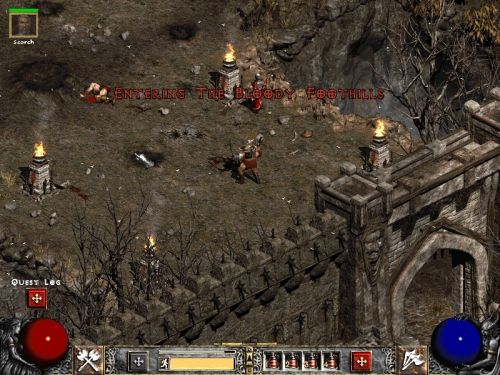
A new ending act, set atop a mountain in barbarian highlands, continued the stellar storyline. One of the greatest levels in all of video gaming was the first area, the Bloody Foothills. You are plunged immediately into a massive battlefield filled with demons and barbarians. Other locations included ice caverns and a demonic temple, and these were filled with new, tough monsters. The big bad boss at the end of Act V was Baal, another ancient evil on par with Diablo himself.
For fans of powerful magic items (basically everyone who ever played Diablo), Lord of Destruction added many shiny new things to collect. Runes and jewels could be found, and added to socketed items. Runes were particularly addicting because they could be merged in all sorts of combinations, giving some of the best abilities in the game. Charms were an interesting addition, taking up inventory space but granting precious bonuses. Class specific sets and ethereal items, powerful but unable to be repaired, kept players clicking and killing in order to find them.
By anyone’s measure, Lord of Destruction was a fantastic expansion. It took what was already one of the best games ever, and made it something legendary. Diablo 2, with the improvements from Lord of Destruction, is by far the greatest game in the series (until next week, at least) and is arguably one of the greatest video games of all time.

Battle.net and Legacy Support
For fans of co-op, perhaps the greatest thing about the Diablo series is Blizzard’s peerless battle.net service. There were very few similar services out there when the first Diablo launched, and even fewer of them were free. Connecting to battle.net gave you a reliable method of playing multiplayer games online with your friends. For many people, playing one of the Diablo games on battle.net was the first experience they had with online co-op. In this era when the online servers for games are taken down within a period of months at times, battle.net is still going strong, supporting both games even after more than a decade has passed since their release.
Similarly, Blizzard has worked diligently to improve Diablo and Diablo 2, fixing bugs and increasing support, for many years. The most recent patch for Diablo 2 was released in 2010, and made significant improvements, including the much-requested free respec, where players could reallocate their skill points. Their ladder system, where players can restart in a clean environment, releases new seasons often; in fact, a new ladder reset happened earlier this month. This level of support for legacy games is unequaled in the industry.

Without a doubt, Diablo and Diablo 2 are among the most influential titles in video game history. The combination of gothic horror, RPG elements, an easy interface, and the endless pursuit of character advancement through better items and skills, along with impeccable co-op options, merged into something truly special. If it wasn’t the birth of the action/RPG genre, it was the most important step in its development. Soon, we’ll all be playing Diablo 3, and clicking our way through Hell once again.
If past history repeats itself, we’ll be playing this latest Diablo game for a dozen years. Think how much your life has changed in that time. Some of our readers might not even have been born when the original Diablo was released on New Year's Eve in 1996. If the latest game and any subsequent sequels remain as popular as the first two games have been, Diablo will become a truly cross-generational series, an establishment in video game culture, for decades to come.